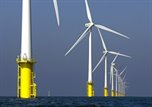Framework for the Assessment of Ecological and Cumulative Effects (KEC) updated
Following on from the 2023 Roadmap for offshore wind energy, the 2030 Roadmap for offshore wind energy was published in March 2018. These documents describe the planned development of offshore wind farms on the Dutch Continental Shelf in the periods leading up to 2023 and 2030.
 After the publication of the first Roadmap, the Framework for the Assessment of Ecological and Cumulative Effects (KEC) was developed to look at how offshore wind may affect protected species in the North Sea. The Framework was then updated after the publication of the second Roadmap to appraise the effects of planned developments on the North Sea in the period leading up to 2030, by which time total capacity is expected to exceed 10.6 Gigawatts. Developments were assessed for a national and an international scenario (southern North Sea). The most important results will be summarised below; the full report can be found here (in Dutch, English version will be available soon).
After the publication of the first Roadmap, the Framework for the Assessment of Ecological and Cumulative Effects (KEC) was developed to look at how offshore wind may affect protected species in the North Sea. The Framework was then updated after the publication of the second Roadmap to appraise the effects of planned developments on the North Sea in the period leading up to 2030, by which time total capacity is expected to exceed 10.6 Gigawatts. Developments were assessed for a national and an international scenario (southern North Sea). The most important results will be summarised below; the full report can be found here (in Dutch, English version will be available soon).
 Offshore Wind Energy Road Map 2023 and 2030 (rvo.nl)
Offshore Wind Energy Road Map 2023 and 2030 (rvo.nl)
The general conclusion for birds is that the populations of the fifteen species assessed will not be affected by either habitat loss or collisions. The Wozep results were used to refine input parameters, especially for flight behaviour and migration routes. The Curlew and the Black Tern now seem to be the migratory bird species of most concern.
The Harbour Porpoise is still assumed to be the most sensitive marine mammal. This update of the KEC concluded that piling sound needs to be mitigated to prevent significant negative effects on the porpoise population. A limit has therefore been advised: the sound level should not exceed 168dB re 1 mPa2s at 750m from the source (assuming wind turbines of 10MW).
There are still a lot of uncertainties for bats: it is not possible to determine the number of collision victims using a model of the kind used for birds. In addition, the size of the population is not known, which obviously makes it difficult to estimate the effect on the population. Given these uncertainties, a mitigation measure has now been suggested that draws on bat numbers in certain weather conditions during the migration period. New information collected as part of Wozep made it possible to refine the mitigation measure from 2015: the new strategy advises the inclusion of temperature and wind direction to reduce both the risk of collision for bats and down times for the wind turbines.